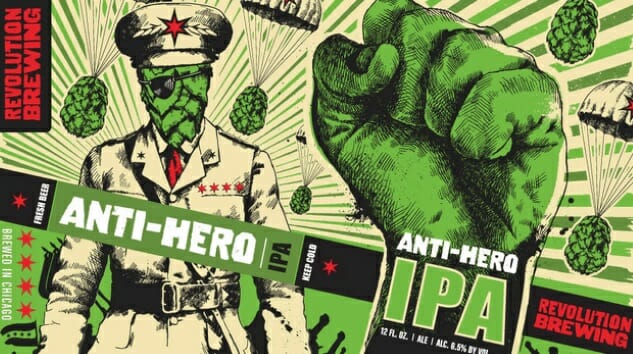My Month of Flagships: Revolution Brewing Anti-Hero IPA
Photos via Revolution Brewing
This essay is part of a series this month, coinciding with the concept of Flagship February, wherein we intend to revisit the flagship beers of regional craft breweries, reflect on their influence within the beer scene, and assess how those beers fit into the modern beer world. Click here to see all the other entries in the series.
Given that this is a series of essays on regional brewery flagships, and given also that my interest in craft beer first dawned as I turned 21 in the mid-2000s, the beers featured in the series have a tendency to predate my own beer drinking days. I wasn’t there, obviously, when Californians were first discovering the wonders of Sierra Nevada Pale Ale in the early 1980s, and I certainly wasn’t participating when the likes of Samuel Adams Boston Lager spearheaded the first microbrewery boom (and then bust) in the 1990s. Most of these beers I’m writing about already had reputations as bastions of the industry by the first time I idly sampled them as a curious college junior in 2007.
That is, with a few exceptions. Because I’ve largely been building this list around breweries who are part of the Brewers Association’s 50 largest craft brewers in terms of production, a few more modern operations have snuck into the mix. And the largest of all of them to be founded in the 2010s, with only one exception, is a brewery I know quite well, because I’ve been visiting since day one—Chicago’s Revolution Brewing Co.
There’s little doubt that Revolution was the “brewery of the decade” for Chicago in the 2010s, at least in terms of widespread cultural impact. There may be several others in that conversation, especially the likes of Half Acre or Off Color, but Revolution was the outfit to truly inherit the mantle of “Chicago’s craft brewery” after Goose Island’s shocking sale in 2011 to Anheuser-Busch InBev, which would of course kick off the cycle of acquisition that consumed most of the last decade. It was Revolution that stood poised to inherit that sense of goodwill and torch-bearing status as the city’s largest and most visible craft brewery, even as they embarked upon and then ultimately refined a barrel-aged beer program that would eventually dethrone Goose Island’s venerable Bourbon County Stout as the city’s most sought-after jewel. All that, and they sold “bacon-fat popcorn” at the brewpub as well.
But despite the headlines Revolution generates these days for its (phenomenal) barrel-aged bruisers, the flagship from the beginning was an excellent little IPA by the name of Anti-Hero. Fitting in snugly in a Revolution lineup with beers named for William Jennings Bryan quotes and famous Socialist candidates for the Presidency, Anti-Hero became by far the beer most intensely associated with brewery, and along with Half Acre’s Daisy Cutter, the gold standard for widely accessible hoppy ales in the city. I can distinctly recall the first time I sampled it in 2010.
Suffice to say, it was a beer that blew me away at the time, possessing a dimension of hop flavor I had rarely encountered in IPAs of the day. I liked it so much, in fact, that I even wrote to Revolution founder Josh Deth in late 2010 (I just found the email), specifically asking for hints as to its hop varietals, in order to brew a homebrew clone of some kind. I eventually brewed that very beer in honor of my younger brother’s 21st birthday, pushing him down the same path of hops exposure. My love for Anti-Hero was sent out into the world for all to see.
That was a decade ago, and you likely don’t need me to tell you how different the beer-scape is today from how it was then. In fact, it’s beers like Anti-Hero that have most clearly illustrated the changing of consumer tastes, not because they’ve changed themselves but because they’ve provided a consistent reference point as the rest of the genre has morphed around them. Even as IPA became fruitier, thicker, juicier, greener and sweeter, Anti-Hero held its ground and increased its distribution, becoming one of the most popular and dependable IPAs in the Midwest. It didn’t reformulate itself to cater to the emerging trend—Revolution wisely decided to let the other entries in the “Hero” series of IPAs do that instead. Rather, Anti-Hero solidified itself as the kind of strong regional flagship that so few breweries founded in the 2010s have managed to legitimately create.